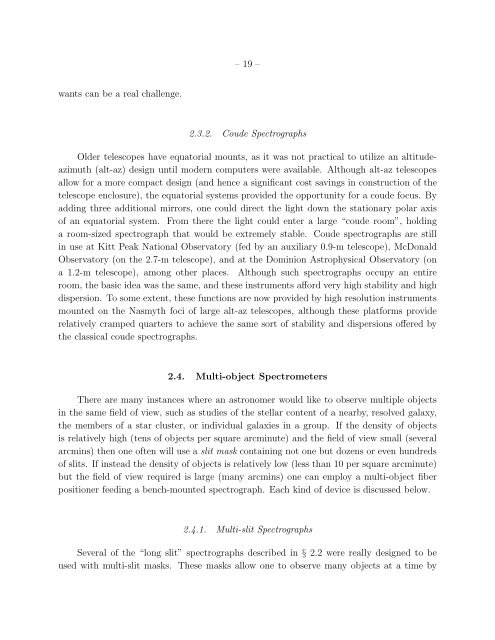Astronomical Spectroscopy - Physics - University of Cincinnati
Astronomical Spectroscopy - Physics - University of Cincinnati
Astronomical Spectroscopy - Physics - University of Cincinnati
You also want an ePaper? Increase the reach of your titles
YUMPU automatically turns print PDFs into web optimized ePapers that Google loves.
– 19 –<br />
wants can be a real challenge.<br />
2.3.2. Coude Spectrographs<br />
Older telescopes have equatorial mounts, as it was not practical to utilize an altitudeazimuth<br />
(alt-az) design until modern computers were available. Although alt-az telescopes<br />
allow for a more compact design (and hence a significant cost savings in construction <strong>of</strong> the<br />
telescope enclosure), the equatorial systems provided the opportunity for a coude focus. By<br />
adding three additional mirrors, one could direct the light down the stationary polar axis<br />
<strong>of</strong> an equatorial system. From there the light could enter a large “coude room”, holding<br />
a room-sized spectrograph that would be extremely stable. Coude spectrographs are still<br />
in use at Kitt Peak National Observatory (fed by an auxiliary 0.9-m telescope), McDonald<br />
Observatory (on the 2.7-m telescope), and at the Dominion Astrophysical Observatory (on<br />
a 1.2-m telescope), among other places. Although such spectrographs occupy an entire<br />
room, the basic idea was the same, and these instruments afford very high stability and high<br />
dispersion. To some extent, these functions are now provided by high resolution instruments<br />
mounted on the Nasmyth foci <strong>of</strong> large alt-az telescopes, although these platforms provide<br />
relatively cramped quarters to achieve the same sort <strong>of</strong> stability and dispersions <strong>of</strong>fered by<br />
the classical coude spectrographs.<br />
2.4. Multi-object Spectrometers<br />
There are many instances where an astronomer would like to observe multiple objects<br />
in the same field <strong>of</strong> view, such as studies <strong>of</strong> the stellar content <strong>of</strong> a nearby, resolved galaxy,<br />
the members <strong>of</strong> a star cluster, or individual galaxies in a group. If the density <strong>of</strong> objects<br />
is relatively high (tens <strong>of</strong> objects per square arcminute) and the field <strong>of</strong> view small (several<br />
arcmins) then one <strong>of</strong>ten will use a slit mask containing not one but dozens or even hundreds<br />
<strong>of</strong> slits. If instead the density <strong>of</strong> objects is relatively low (less than 10 per square arcminute)<br />
but the field <strong>of</strong> view required is large (many arcmins) one can employ a multi-object fiber<br />
positioner feeding a bench-mounted spectrograph. Each kind <strong>of</strong> device is discussed below.<br />
2.4.1. Multi-slit Spectrographs<br />
Several <strong>of</strong> the “long slit” spectrographs described in § 2.2 were really designed to be<br />
used with multi-slit masks. These masks allow one to observe many objects at a time by

















